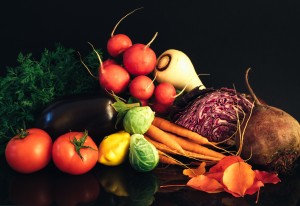Compared to animal foods, the colors of all kinds of vegetables and fruits can be colorful and gorgeous. The bright green color of broccoli, the purple color of eggplant, the yellow color of carrots, and the red color of peppers – why are these vegetables different? What determines these colors?
Phytochromes are a combination of two types of pigment molecules: water-soluble cytosolic pigments and lipid-soluble chloroplast pigments. Examples of the former include anthocyanins, flavonoids that give color to flowers; for the latter, carotenoids, luteins and chlorophylls are common. Water-soluble pigments are soluble in ethanol as well as regular water but insoluble in other organic compounds such as ether and chloroform. The fat-soluble pigments are more difficult to dissolve in methanol, but easily soluble in higher concentrations of ethanol and other organic solvents. When exposed to lead acetate reagent, water-soluble pigments will precipitate and can be adsorbed by activated carbon; the colors will also change depending on the pH.

1.Chlorophyll
Chlorophyll is widely found in the leaves, fruits and algae of higher plants, and is an important component of plant chloroplasts, which exists in combination with proteins in living organisms.
Chlorophyll is a blood tonic, promotes hematopoiesis, activates cells, antibacterial and anti-inflammatory effects, etc. In recent years, scientists have found that chlorophyll has the effect of inhibiting the production of ai cells.
Foods that contain chlorophyll include: kale, alfalfa sprouts, lettuce, spinach, broccoli, lettuce, etc.
Chlorophyll dominates the color green, a very familiar group of colors that are found in almost all plant species. Some may wonder, what about carrots? What about these ingredients whose appearance and color do not match green at all? In fact, carrots also contain chlorophyll, which is not low, but the “green” is covered by the “yellow and orange”.
2.Carotenoid
Carotenoids is a general term for the various isomers of carotenoids and their derivatives found in plants. It is a group of colored substances that are widely found in nature, and was first discovered in carrots, hence the name carotenoids.
Studies have shown that a higher intake of human carotenoids can reduce age-related prostate disease and age-related retinal macular degeneration. Therefore, natural carotenoids have been approved by the Ministry of Health for use as anti-radiation health food. Different carotenoids have different molecular structures, and by the end of the 20th century, more than 600 carotenoids had been discovered.
Foods containing carotenoids: carrots, pumpkin, tomatoes, citrus, corn, etc.
3.Flavonoid
Flavonoid pigments, also known as anthocyanins, are also water-soluble pigments. From the chemical structure, it is a water-soluble phenolic substance. It widely exists in the plant kingdom, including various derivatives, and thousands of species have been found. Flavonoids are rarely found in nature as monomers. Different types of flavonoids exist in plants of different families, orders, genus, and species; in different organs of plants such as bark, root, and flower, there are different flavonoids. Nearly 400 varieties have been discovered so far, which are colorless, light yellow or bright orange, and their color is greatly affected by pH.
As a natural food coloring, anthoxanthin is safe, non-toxic, rich in resources, and has certain nutritional and pharmacological effects. It has great application potential in food, cosmetics, and medicine.
In recent years, a large number of research results at home and abroad have shown that flavonoids have anti-oxidation, elimination of free radicals, anti-lipid peroxidation activity, prevention of cardiovascular diseases, antibacterial, antiviral, and antiallergic effects. Vegetables, fruits and grains in the plant kingdom are rich in flavonoid pigments.
Foods containing flavonoid pigments: sweet peppers, celery, red onions, green tea, citrus, grapes, buckwheat, etc.
4.Anthocyanin
Anthocyanins: Because of their important “anti-oxidant activity”, anthocyanins are very well known and claimed as a “gimmick” by many companies. More than 300 types of anthocyanins have been identified, including blue, purple, red and orange. These pigments are water-soluble. Anthocyanins can show different colors as the pH changes. You should have a similar experience when cooking cabbage (red) in water.
The chemical nature of anthocyanins is very unstable, and the color will change brilliantly with the change of pH, which is red below 7, purple at 8.5, violet-blue at 11, and yellow, orange or even brown at more than 11. Oxygen, light or higher temperatures can transform foods with high anthocyanin content into brown. In addition, discoloration caused by contact with iron should be avoided as much as possible when processing them.
Proanthocyanidins are able to scavenge free radicals in the body, have strong antioxidant activity, and can regulate immunity and play an anti-cancer role.
Foods containing anthocyanins: purple potatoes, black rice, purple corn, purple kale, eggplant, perilla, carrots, beets, etc.
With people advocating natural, the pursuit of health and safety first psychological requirements, as well as China’s entry into the WTO facing the needs of the global economy, the development of edible natural pigments more rapidly, according to statistics, from 1971 to 1981 the world published 126 patents for food coloring, of which 87.5% are edible natural pigments.
With the development of society, the use of natural colorants has gradually become popular in the food and cosmetic industries, and the techniques used have gradually improved, making natural pigments an indispensable part of beautifying life.
Our enterprise goal is “Make The World Happier And Healthier“.
For more plant extract information, you can contact us at ant time!!
References:https://www.zhihu.com/
Post time: Feb-03-2023






